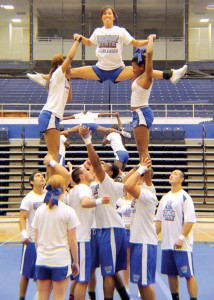

Former Georgia State cheerleader Taylor Jackson told The Signal, “I had zero help financially but was expected to constantly pour my heart, soul and body into a sport that I used to love. It was causing me more stress. Something had to give.”
As of March 2016, the Georgia State cheerleaders have yet to regain scholarships or stipends that were cut with the spirit squad budget in 2010.
The cheerleading program currently doesn’t offer any athletic scholarships or stipends to its athletes. Instead, the cheerleaders are provided with Nike shoes, practice clothes, gear, priority registration, training room access, sports medicine treatment for injuries, paid travel and game day meals.
However, in the eyes of the NCAA, Georgia State’s cheer program is not considered a university sport like football, soccer and golf. This association gives Georgia State money for every NCAA approved sport the school has, but this contribution is nearly not enough to support each sport’s program.
Even though schools such as Auburn University, Spring Hill College and Mercer University aren’t awarded money from the NCAA to keep their cheerleading program active, their programs still exist with stipends or scholarship.
After Georgia State’s football team became a part of the Football Bowl Subdivision in 2012, the highest level of collegiate football, the cheerleading scholarship situation remained unchanged.
Georgia State’s cheer team practices at 6 a.m. three times a week and cheer at two games each week. The Georgia State marching band, which is a part of the spirit program, also practices three times a week and performs at two games every week.
However, members of the marching band receive stipends that cover all book expenses and some of their tuition.
Universities, such as Georgia Tech and Clemson University, that offer their cheerleaders scholarships and pay for them to compete in national competitions have about 3-5 athletes leave each year due to personal reasons. Whereas, a third of Georgia State’s cheer rosters quit at the end of each season, according to Head Spirit Coach Darryl Lyons.
Jackson left the Georgia State cheerleading team after deciding that working two jobs and being a student athlete with no financial benefit was too much to handle. She, like some of the other cheerleaders that eventually decided to leave the spirit program, was faced with the decision to either continue cheering without financial help or to give up her dream of being a collegiate cheerleader.
In addition to the fact that the cheerleaders are not awarded scholarships or stipends, the team is responsible for funding their participation in cheerleading competitions. Because of how expensive it is to perform at national cheerleading events, the cheerleaders only perform in a limited amount. This year the competition cheerleaders placed first place at Cheersport, a national cheerleading competition, bringing Georgia State’s athletic department more athletic accolades.
Lyons told The Signal he’s confident that his team’s skills will eventually pay off.
“I believe the cheerleading program will receive more money in the future due to the fact the athletic department sees how hard the team works,” he said. “We’ve now moved into the big ranks [in football] and that’s probably going to help change everything for the better.”
